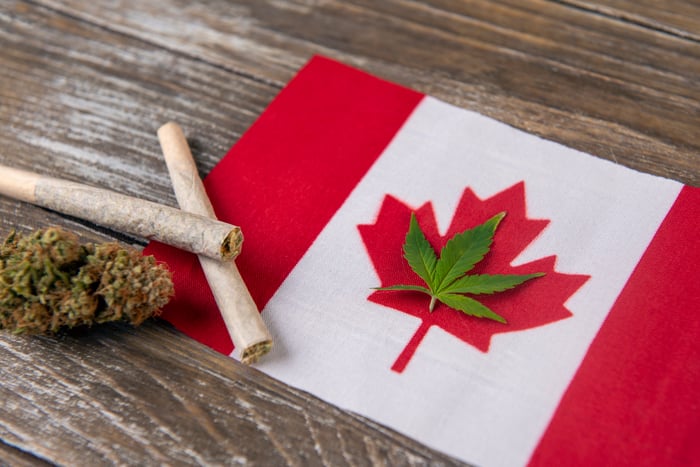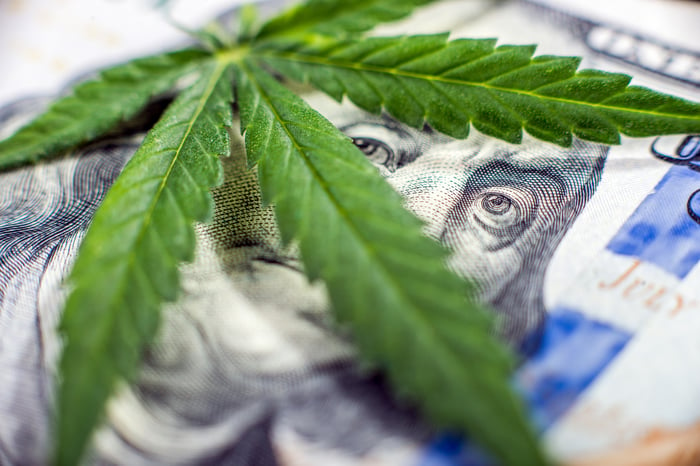During the first quarter, and in each of the previous three years, marijuana stocks were the hottest thing since sliced bread. The expectation had been that global cannabis sales would grow many times over in the years to come, potentially hitting as much as $200 billion annually by 2030, according to investment bank Stifel. These pie-in-the-sky sales estimates had been more than enough to fuel huge gains in pot stocks.
But things have changed in a big way since the end of March. Marijuana stocks have been in a precipitous downtrend for more than seven months, with pretty much every cannabis investor looking at double-digit percentage declines across the board.

Image source: Getty Images.
If you own pot stocks, you've seen a lot of money disappear lately
However, cannabis stock weakness becomes even more telling when ditching the percentages and putting this downtrend into easier-to-understand terms, such as dollars lost. Since April, 25, 2019, which just happens to be the day I logged the market caps of 15 of the largest pot stocks in the world, about $35 billion in value has been wiped away. Here's a summary, in descending order, of some of the largest declines in market value over the past 6.5 months:
- Canopy Growth (CGC -1.01%): $10.01 billion in market cap lost
- Aurora Cannabis: $5.6 billion
- Cronos Group: $2.79 billion
- Tilray: $2.79 billion
- Curaleaf Holdings: $2.67 billion
- Acreage Holdings: $2.11 billion
- Harvest Health & Recreation: $2 billion
- GW Pharmaceuticals: $1.72 billion
- MedMen Enterprises (MMNFF): $1.15 billion
- Cresco Labs: $1.03 billion
- HEXO (HEXO): $0.95 billion
- Charlotte's Web: $0.73 billion
- Aphria (APHA): $0.72 billion
- OrganiGram Holdings: $0.44 billion
- Trulieve Cannabis: $0.23 billion
Add this up, and it's just shy of $35 billion market cap that's gone up in smoke since late April.
Why are cannabis stocks such a train wreck? In my view, it boils down to these three factors.

Image source: Getty Images.
Canadian supply issues aren't easily resolvable
First, there's the 800-pound gorilla in the room: Canada's ongoing supply problems.
Regulatory agency Health Canada has been tasked with reviewing and approving cultivation and sales licenses for the legal industry. Unfortunately, it came into 2019 with a backlog of more than 800 applications to review. Even with changes to its cultivation licensing application process – all growers must now have completed their cultivation facilities before submitting their licensing application – the agency will need numerous quarters to work through its backlog. This means lengthy delays in bringing product to market.
Aphria, for instance, waited somewhere between 18 and 21 months for licensing approval at its joint venture Aphria Diamond facility. This grow site will be responsible for 140,000 kilos of Aphria's 255,000 kilos of peak annual output.
We've also seen problems in opening enough dispensaries in certain provinces. Ontario, which is home to 14.5 million Canadians, has only 24 open dispensaries, or about one for every 604,200 people. There's room in Ontario for 25 to 40 times as many retail locations, but certain provinces have been slow to approve retail license applications.
Also, don't overlook the delayed launch of derivative products in Canada. The expectation had long been that edibles, vapes, concentrates, topicals, and infused beverages, would wind up on retail shelves no later than October 2019. However, the current timeline doesn't foresee these products in dispensaries until mid-December.
Quebec-based grower HEXO cited this delayed launch of derivatives as one of the primary reasons its sales fell well short of prior forecasts in the fiscal fourth quarter. Derivatives are a much higher margin product than dried cannabis flower, so their slow-stepped emergence means pushing any chance of profitability for companies like HEXO out even further.

Image source: Getty Images.
High tax rates in U.S. states are driving consumers to the black market
Within the United States, high tax rates have been responsible for weakness in the cannabis industry, although the impact of taxation varies from state to state.
California, which projects as the largest marijuana market in the world by annual sales, has made it virtually impossible for its legal pot companies to compete against the black market. Consumers are absorbing high state and local tax rates, a 15% excise tax, and a wholesale tax on either dried cannabis flower or cannabis leaves. All told, this works out to an aggregate tax of as much as 45%, and it still doesn't include added expenses, such as laboratory testing for quality that are most certainly being factored into legal-channel pricing.
Multistate operator MedMen Enterprises, which aims to establish a large presence on California soil, should be seeing sales go through the roof, especially with the Golden State having opened its doors to recreational sales on Jan. 1, 2018. However, sales actually fell in California by $500 million in 2018 to $2.5 billion, and MedMen's sequential quarterly sales have only jumped by 5% and 10%, respectively, in the company's two most recent quarters.
Not to pick on California, but its legalization effort also takes a hit because of the fact that nearly 80% of its municipalities have denied dispensaries the right to open. With so many consumers lacking easy access to legal marijuana, it's rolled out the green carpet for the black market.

Image source: Getty Images.
Operating results have been abysmal
Finally, there's no denying that operating results for marijuana stocks haven't been up to snuff, mainly because of the issues described. Then again, some pot stocks have taken poor operating results to a whole new level.
Canopy Growth, for example, has been an absolute mess come earnings time. When the company reported its fiscal first-quarter operating results in August, it delivered the lowest margins of its peers, as well as a loss that surpassed $1.28 billion Canadian. Even removing the extinguishment of warrants, which resulted in much of this loss, as well as other one-time losses and benefits, Canopy Growth lost about CA$216 million on an operating basis in Q1 2020.
What's perhaps most notable about this loss is that CA$77.1 million in expenses came from share-based compensation. Former co-CEO Bruce Linton felt that the best way to create loyalty among employees was to grant them long-term-vesting stock. Unfortunately, this is also a means of driving up costs on the company's income statement. Because of Linton's aggressive expansion tactics, and this share-based compensation, Canopy looks to be at least two years away from any shot at recurring profits.
Though all of these noted issues is fixable, the maturation of the pot industry, and adjustments made by regulators, will be a slow and ongoing process. Patience is a must if you're a marijuana stock investor.





